Kirtan is a broad term referring to various forms of devotional singing commonly done in South Asian traditions. It is a core practice in the Hindu and Sikh faiths that is becoming increasingly popular around the world among people of all ethnicities. Beyond its expected propagation within Hindu and Sikh diasporas, kirtan is also spreading among members of new religious movements such as ISKCON and the 3HO/Sikh Dharma, who may engage in this practice as part of their daily cultivation. Even more broadly, a form of what has been called "neo-kirtan" has been gaining popularity in the yoga and New Age communities, with several kirtan artists nominated for the Grammy awards over the years. Moreover, in the wake of the mindfulness and yoga movements, there is an emerging engagement of kirtan singers with public healthcare and correctional institutions. Thus, we can say that kirtan is developing as a transnational and transcultural phenomenon. Indeed, the broader cultural implications and deepening social penetration that this practice has achieved over the past five decades suggest that it is attaining permanent status in the world’s religious soundscape. This research explores the practice of kirtan as it has been re-created in the United States, Canada, and Brazil through multi-sided interactions that generate new cultural patterns in an ongoing process of cross-pollination. Approaching kirtan as a type of ’technology of the self’, this research combines textual, historical, and ethnographic sources to address the questions of how this practice is adopted and adapted in the Americas and how it has been shaping identities, communities, and traditions.
Keywords: mantra, kirtan, yoga, bhakti, music, new religious movements, transculturation.












